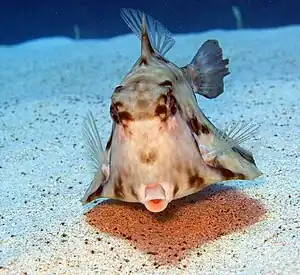| Camel cowfish | |
|---|---|
%252C_parque_nacional_Ras_Muhammad%252C_Egipto%252C_2022-03-27%252C_DD_146.jpg.webp) | |
| Scientific classification | |
| Domain: | Eukaryota |
| Kingdom: | Animalia |
| Phylum: | Chordata |
| Class: | Actinopterygii |
| Order: | Tetraodontiformes |
| Family: | Ostraciidae |
| Genus: | Tetrosomus |
| Species: | T. gibbosus |
| Binomial name | |
| Tetrosomus gibbosus | |
Tetrosomus gibbosus, commonly called camel cowfish because of the hump on its dorsal keel, is one of 22 species in the boxfish family, Ostraciidae.[2] It is a ray finned fish. Other common names include helmet cowfish, humpback turretfish and thornbacked boxfish. It is most closely related to T. reipublicae, the smallspine turretfish.[3] T. gibbosus is a species of boxfish found in the wide Indo-West Pacific. It has been recorded since 1988 on rare occasions in the Levantine waters of the Mediterranean Sea, likely following entry via the Suez Canal.[4] It is the first species from the family Ostraciidae to be found in the Mediterranean Sea.[5]
It carries some value in the aquarium trade, but is difficult to keep.[6]
Description

T. gibbosus is normally around 20 centimetres (7.9 in) long when it is fully grown, but can reach up to 30 centimetres (12 in) in length.[7] Fish in the genus Tetrosomus are characterized by the presence of a carapace, a hard upper shell formed by thick scale plates.[3] The body is completely encased in this bony shell, except for a few small openings such as the mouth, eyes, and gills.[8] The mouth is small with fleshy lips and conical teeth usually numbering less than 15.[8]
Biology
T. gibbosus has poisonous flesh, organs, and spines, and is known to secret poisonous mucus in defense or when it is disturbed.[7] This poison can be fatal to humans or other marine organisms that come into contact with it.[7] T. gibbosus is hermaphroditic; all individuals of this species are born female, but some may change into males as they grow.[7] Juveniles live together in small schools, but individuals become solitary as they mature into adulthood.[7] T. gibbosus is an omnivorous species, and its diet is known to include seaweeds, sponges, molluscs, worms, and crustaceans found on the bottom of its habitat.[7]
Distribution and habitat
T. gibbosus lives in shallow tropical waters or warm seas with muddy bottoms and can sometimes be seen near shallow seagrass beds.[9][8] It is also found in coral reefs.[10] It is considered an endangered species in the South China Sea.[10]
Lessepsian migration
A Lessepsian migration refers to the migration of a marine species from the Red Sea to the Mediterranean Sea, facilitated by the opening of the Suez Canal in 1869. A species is considered Lessepsian when it has completed this migration and established a population. T. gibbosus was first found in the Mediterranean Sea in 1988.[11] Both the Red Sea and the Mediterranean Sea have similar salinity levels and temperature ranges, which allows for an easier transition between of these bodies of water.[12][5] It is thought that Lessepsian species migrated due to changing climates, since the geographic land barrier was removed when the Suez Canal was completed.[11] T. gibbosus is now considered an invasive species in the Mediterranean Sea, as this is not included in its native distribution.[11] It is also considered an established species because it has established a growing population and has been found in multiple locations.[12] It is the first species from the family Ostraciidae to be found in the Mediterranean Sea.[5] Due to its inability to swim long distances, T. gibbosus likely took multiple generations to migrate from the Red Sea to the Mediterranean Sea; this is thought to have happened, in part, from northward currents moving eggs and larvae north towards the Mediterranean Sea.[5]
References
- ↑ Matsuura, K. (2010). "Tetrosomus gibbosus". IUCN Red List of Threatened Species. 2010: e.T154933A4671390. doi:10.2305/IUCN.UK.2010-4.RLTS.T154933A4671390.en. Retrieved 11 November 2021.
- ↑ Matsuura, Keiichi (11 November 2014). "Taxonomy and systematics of tetraodontiform fishes: a review focusing primarily on progress in the period from 1980 to 2014". Ichthyological Research. 62 (1): 72–113. doi:10.1007/s10228-014-0444-5.
- 1 2 Santini, Francesco; Sorenson, Laurie; Marcroft, Tina; Dornburg, Alex; Alfaro, Michael E. (January 2013). "A multilocus molecular phylogeny of boxfishes (Aracanidae, Ostraciidae; Tetraodontiformes)". Molecular Phylogenetics and Evolution. 66 (1): 153–160. doi:10.1016/j.ympev.2012.09.022. PMID 23036494.
- ↑ Atlas of Exotic Fishes in the Mediterranean Sea (Tetrosomus gibbosus). 2nd Edition. 2021. 366p. CIESM Publishers, Paris, Monaco.https://ciesm.org/atlas/fishes_2nd_edition/Tetrosomus_gibbosus.pdf
- 1 2 3 4
- Foka, Maria; Economidis, Panos (2007). "Allochthonous and vagrant ichthyofauna in Hellenic marine and estuarine waters". Mediterranean Marine Science. Hellenic Centre for Marine Research. 8: 67–90. doi:10.12681/MMS.163. eISSN 1108-393X. ISSN 1791-6763. S2CID 83666960.
- This review cites this research.
- Spanier, E.; Goren, M. (May 1988). "An Indo-Pacific trunkfish Tetrosomus gibbosus (Linnaeus): first record of the family Ostracionidae in the Mediterranean". Journal of Fish Biology. 32 (5): 797–798. doi:10.1111/j.1095-8649.1988.tb05420.x. S2CID 84396752.
- ↑ "Saltwater Aquarium Fish for Marine Aquariums: Helmet Cowfish". www.liveaquaria.com. Retrieved 2019-04-26.
- 1 2 3 4 5 6 Ketabi, Ramin; Jamili, Shahla. "Tetrosomus gibbosus (Linnaeus, 1758)". aquaticcommons.org.
- 1 2 3 Matsuura, Keiichi (11 November 2014). "Taxonomy and systematics of tetraodontiform fishes: a review focusing primarily on progress in the period from 1980 to 2014". Ichthyological Research. 62 (1): 72–113. doi:10.1007/s10228-014-0444-5.
- ↑ Froese, Rainer; Pauly, Daniel (eds.) (2015). "Tetrosomus gibbosus" in FishBase. April 2015 version.
- 1 2 Arai, Takaomi (12 September 2014). "Diversity and conservation of coral reef fishes in the Malaysian South China Sea". Reviews in Fish Biology and Fisheries. 25 (1): 85–101. doi:10.1007/s11160-014-9371-9. S2CID 14711917.
- 1 2 3 Ben Rais Lasram, Frida; Mouillot, David (27 May 2008). "Increasing southern invasion enhances congruence between endemic and exotic Mediterranean fish fauna". Biological Invasions. 11 (3): 697–711. doi:10.1007/s10530-008-9284-4. S2CID 24327290.
- 1 2 Mavruk, Sinan; Avsar, Dursun (14 August 2007). "Non-native fishes in the Mediterranean from the Red Sea, by way of the Suez Canal". Reviews in Fish Biology and Fisheries. 18 (3): 251–262. doi:10.1007/s11160-007-9073-7. S2CID 43648595.
External links
- Humpback Turretfish @ Fishes of Australia
